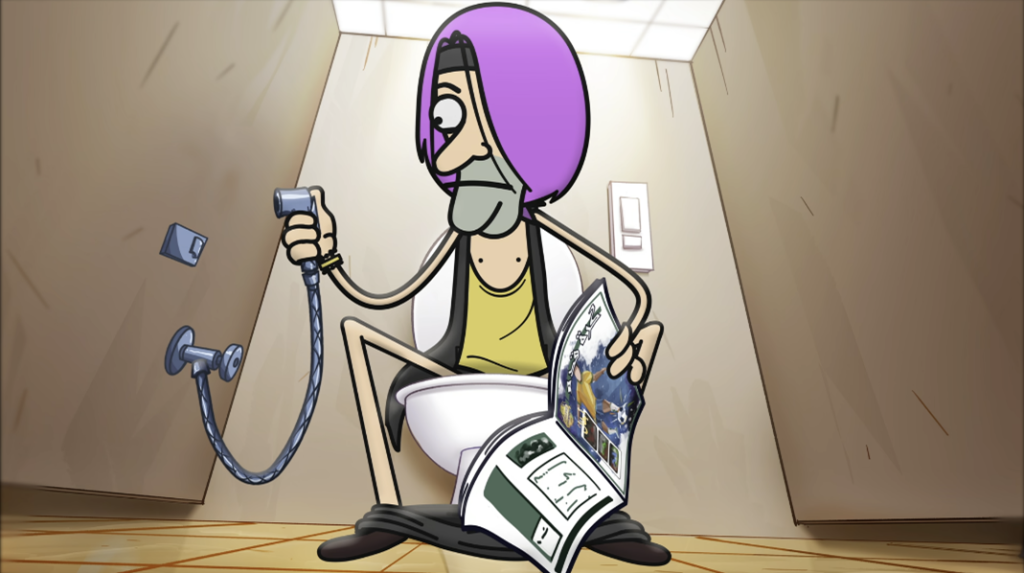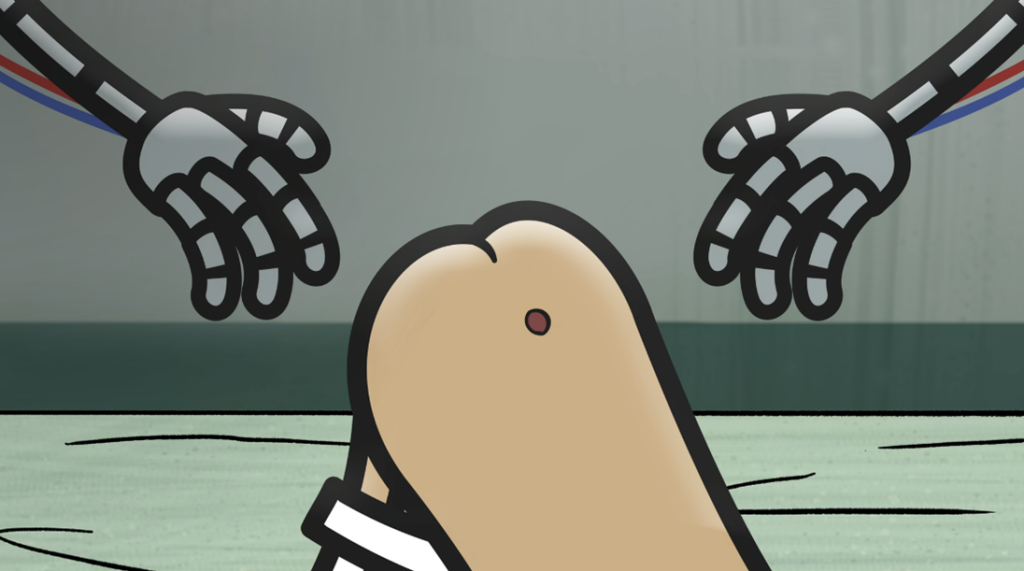Animation is a powerful medium for cultural critique, utilizing caricature, fantasy, and exaggeration to address sensitive issues without causing significant offense. The animated adult series Masameer County (2021) exemplifies this by transgressing societal boundaries and exposing taboo topics. This blog explores how the show has critiqued societal and cultural norms in Saudi Arabia. I demonstrate how the series has depicted content that is deemed offensive in a Muslim and Arab society yet has remained popular by using animation to circumvent restrictions.
The show relies on situational irony, stereotypes, and humor to address many of the cultural and social issues in Saudi Arabia that have the potential to trigger grievances and offense. In his research on Arab animated sitcoms, Omar Sayfo, argues that satire makes social criticism more palatable.[1] Sean Foley characterizes the humor in Masameer (2011) as a mix of highbrow and lowbrow, noting that its use of irony is deliberately ambiguous, allowing for multiple viewer interpretations.[2] This helps the episodes avoid direct social criticism. I argue that animation is an added factor that facilitates evading restrictions and eases the impact of offense.
In recent years, Saudi Arabia has transformed towards a more secular state, yet remnants of strict Islamic principles and conservative cultural norms persist. Starting in 2011, platforms like YouTube saw a surge in Saudi content as creators found a relatively free space on social media to express frustrations and engage in critical discourse. During this period, Malik Nejer’s adult animated series Masameer (Screw Nails) emerged.
My focus is on Masameer County (2021), made exclusively for Netflix, which is significantly transformed from the original series. The production quality is superior, with more complex storylines, moving beyond the simple situational comedy of the original YouTube show. The show continues to push boundaries, with the producers prioritizing creative freedom over societal reactions, allowing them to challenge cultural and religious restrictions. [3]
Animation has shielded the series from the ire of a strict society and religious policing. The perception of animation as a children’s medium, with its inherent innocence, has made it a suitable choice for many Arab animated sitcoms discussing sensitive topics. Animation allows hidden meanings, metaphors, and analogies to go unnoticed. [4] Paul Wells asserts that the stigma of animation as a children’s medium means that “graphic or three-dimensional expression in the animated film disguises the apparent explicitness of this imagery and dilutes its impact.” [5] Because animation appears less realistic, it can be perceived as less offensive or provocative.
Comic exaggeration in animation, as Wells notes, is effective in illustrating taboo issues.[6] The characters in Masameer are caricatured burlesque figures that evoke humor through their mere appearance. They interact with various anthropomorphic animals, such as a talking dog who is a recurring character, and a donkey with glasses who serves as a psychiatrist. One of the main characters, Saltouh, whose name translates to “trivial male” or “someone poor with nothing in hand,” is designed with a large bent nose, a squeaky voice, and an inherently humorous appearance. Comparable to the characters of Beavis and Butt-head (1993), who represent contemporary American idiocy,[7] Saltouh embodies the naive young Saudi male who navigates society and life with little control. He does not instigate the absurd and extreme situations he encounters; rather, he is a victim. This character design and development render Saltouh as a sympathetic figure, absolving him from the transgressions occurring within the show.
Each episode critically examines various social topics, including Islamic extremism, corruption, and everyday struggles. In the first episode of the first season, titled “Ice Cream,” a wealthy character, sheltered his entire life, decides to venture out alone to get ice cream. His naïve journey leads him to a prostitute’s house, potentially marking the first portrayal of prostitution in Saudi media. The scene’s provocative nature, with the prostitute stroking his face and sucking her finger, pushes cultural boundaries and challenges taboos.
The second episode, “Washingtonia,” features a religious extremist and a liberal adapting to a major social shift. A notable scene involves the liberal character, Nadir, with dyed purple hair, sitting on the toilet. Muslims often say Allah yikramak (May Allah bless you) before mentioning the bathroom out of respect and etiquette, making this scene’s crude imagery and frequent swearing particularly offensive.
In the fourth episode, “Pimple,” the plot centers around a pimple on the buttocks of the character Saltouh. A nude buttock, which would never be shown in Saudi media, is humorously exposed throughout the episode as various people inspect and bet on the pimple. This storyline runs parallel to a more serious subplot of a son struggling to secure medical treatment for his sick mother due to insurance issues, highlighting societal paradoxes.
While Masameer County is mild compared to Western adult animation, it boldly pushes through cultural and traditional boundaries due to its animated form. The characters’ exaggerated interactions, anthropomorphic designs, humorous caricatures, and dialogue enhance the humor and highlight the self-referential nature of the format. This creates a critical distance, allowing viewers to engage with challenging content in a more tolerable form. This supports Eisenstein’s belief in animation’s unique ability to transform and adapt, conveying complex ideas and emotional experiences that might be constrained in more realistic media forms. This flexibility enables animation to effectively address and critique societal norms, providing a unique medium for challenging expressions and personal liberation.
Bibliography
DeRochi, Jack. “”What Have You Learned?”: Considering a New Hermeneutic of Satire In “Family Guy”.” Studies in American humor 3, no. 17 (2008): 35-48.
Foley, Sean. Changing Saudi Arabia: Art, Culture, and Society in the Kingdom. Boulder, CO: Lynne Rienner Publishers, 2019. doi:10.1515/9781626377868.
Sayfo, Omar Adam. “Arab Sitcom Animations as Platforms for Satire.” In The Power of Satire, edited by Marijke Meijer Drees and Sonja de Leeuw, United States: John Benjamins Publishing Company, 2015.
Wells, Paul. Understanding Animation. London: Routledge, 1998.
Malak Quota is a Saudi filmmaker and animator. She is also an educator and film researcher. She has an MFA in Animation from the University of Southern California and is pursuing a PhD in Film Studies from the University of Essex. Her films have been screened internationally and won several awards. She has worked in an array of industries and productions from gaming to digital agencies and is currently an associate professor at Zayed University in the UAE.
[1] Omar Adam Sayfo, “Arab Sitcom Animations as Platforms for Satire,” in The Power of Satire, ed. Marijke Meijer Drees and Sonja de Leeuw (United States: John Benjamins Publishing Company, 2015). 84
[2] Sean Foley, Changing Saudi Arabia: Art, Culture, and Society in the Kingdom (Boulder, CO: Lynne Rienner Publishers, 2019). 133
[3] Interview with Abdulaziz Almuzeini, June 9th, 2022
[4] Sayfo, “Arab Sitcom Animations as Platforms for Satire,” 84.
[5] Paul Wells, Understanding Animation (London ;: Routledge, 1998). 175
[6] Wells, Understanding Animation. 175
[7] Jack DeRochi, “”What Have You Learned?”: Considering a New Hermeneutic of Satire In “Family Guy”,” Studies in American humor 3, no. 17 (2008). 36



Thank you, Malak, for this thoughtful article. I’m proud to have had you in my class years ago. You came to mind as I’ve read of US and Ukraine in Jeddah discussing peace. Your good work has more effect than you know.